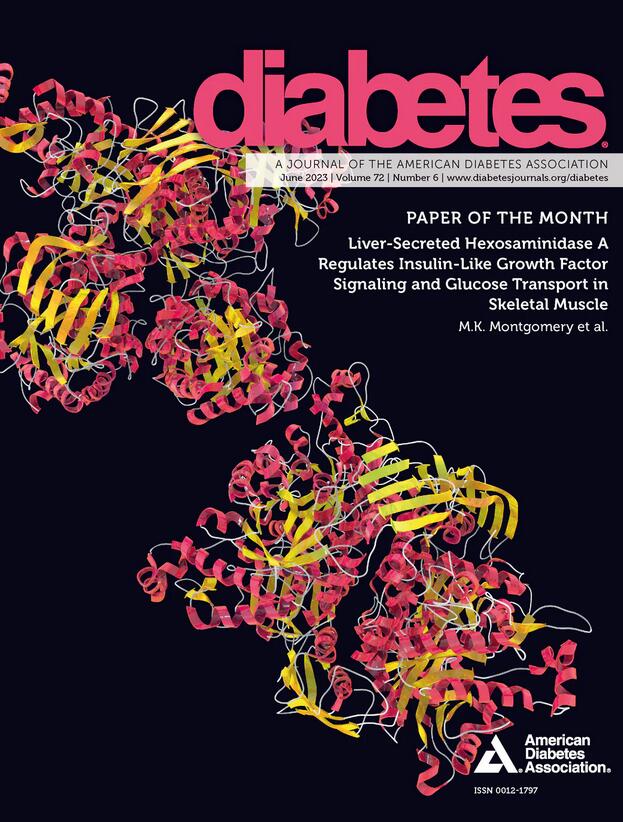1666-P: Effect of Obesity in Family History (FH) on the Prevalence of Type 2 Diabetes Mellitus (T2DM), Hypertension (HT), and Dyslipidemia (DL)
IF 6.2
1区 医学
Q1 ENDOCRINOLOGY & METABOLISM
引用次数: 0
Abstract
Heritability and obesity are strongly associated with the prevalence of T2DM, HT, and DL. We compared the effects of an FH of T2DM, HT, and DL combined with obesity on the prevalence of each in the same population. Of 41931 participants who underwent health checkups, the effects of an FH and BMI on the prevalence of those conditions were analyzed cross-sectionally. Prevalences of T2DM, HT, and DL were 5%, 20%, and 48%, respectively. Logistic regression analysis showed that ORs increased for all three as the number of FH positive cases increased and was most pronounced for T2DM. An FH of obesity and increased BMI were additively associated with the prevalence of the three diseases compared to BMI 20.0-21.9 and no positive FH (Fig. A). In addition, the combination of the number of family members with FH positivity (0,1, 2, ≥3) and obesity was additively associated with an increased FH of the three diseases compared to non-obesity and no FH of any of these diseases (Fig. B). For T2DM, the OR increased sharply in non-obese participants when the number of those with an FH of T2DM was ≥3 (14.4 [8.88-23.5]), but in obese participants the OR increased sharply when the number of those with an FH of T2DM was 2 (12.2 [8.85-16.9]) (Fig. B). Results suggest that, especially for T2DM, avoidance of obesity may be effective in reducing the prevalence of these disorders in those with many FH-positive family members. Disclosure I. Ikeda: None. K. Fujihara: None. Y. Takeda: None. C. Horikawa: None. S. Kodama: None. E.D. Ferreira: None. Y. Mori: None. T. Kadowaki: None. R. Yamamoto-Honda: None. Y. Arase: None. H. Sone: Research Support; Novo Nordisk, Astellas Pharma Inc., Kowa Company, Ltd., Kyowa Kirin Co., Ltd., Eisai Inc., Sumitomo Dainippon Pharma Co., Ltd.1666-P:家族史(FH)中的肥胖对 2 型糖尿病(T2DM)、高血压(HT)和血脂异常(DL)患病率的影响
遗传性和肥胖与 T2DM、HT 和 DL 的患病率密切相关。我们比较了 T2DM、HT 和 DL 的 FH 与肥胖结合对同一人群中每种疾病患病率的影响。在接受健康检查的 41931 名参与者中,我们横向分析了 FH 和体重指数对这些疾病患病率的影响。T2DM、高血压和DL的患病率分别为5%、20%和48%。逻辑回归分析表明,随着 FH 阳性病例数的增加,这三种疾病的 ORs 也随之增加,其中以 T2DM 最为明显。与体重指数(BMI)20.0-21.9 和 FH 无阳性相比,肥胖 FH 和体重指数(BMI)增加与这三种疾病的患病率呈叠加关系(图 A)。此外,与非肥胖和无 FH 的家庭成员相比,FH 阳性(0、1、2、≥3)和肥胖的家庭成员数量与三种疾病的 FH 增加呈叠加关系(图 B)。就 T2DM 而言,当 T2DM 的 FH 人数≥3 时,非肥胖参与者的 OR 急剧增加(14.4 [8.88-23.5]),但当 T2DM 的 FH 人数为 2 时,肥胖参与者的 OR 急剧增加(12.2 [8.85-16.9])(图 B)。结果表明,尤其是对于 T2DM 患者,避免肥胖可能会有效降低有许多 FH 阳性家族成员的人群中这些疾病的患病率。披露 I. Ikeda:无。K. Fujihara:无:无。Y. Takeda:无:Y. Takeda: None.C. Horikawa:无。S. Kodama:无。E.D. Ferreira: None.Y. Mori: None.T. Kadowaki:无。R. Yamamoto-Honda:无。Y. Arase:无。曾根 H:研究资助;诺和诺德公司、安斯泰来制药公司、Kowa Company, Ltd.、Kyowa Kirin Co., Ltd.、卫材公司、住友大日本制药株式会社、Kyowa Kirin Co., Ltd.、Eisai Inc.
本文章由计算机程序翻译,如有差异,请以英文原文为准。
求助全文
约1分钟内获得全文
求助全文
来源期刊

Diabetes
医学-内分泌学与代谢
CiteScore
12.50
自引率
2.60%
发文量
1968
审稿时长
1 months
期刊介绍:
Diabetes is a scientific journal that publishes original research exploring the physiological and pathophysiological aspects of diabetes mellitus. We encourage submissions of manuscripts pertaining to laboratory, animal, or human research, covering a wide range of topics. Our primary focus is on investigative reports investigating various aspects such as the development and progression of diabetes, along with its associated complications. We also welcome studies delving into normal and pathological pancreatic islet function and intermediary metabolism, as well as exploring the mechanisms of drug and hormone action from a pharmacological perspective. Additionally, we encourage submissions that delve into the biochemical and molecular aspects of both normal and abnormal biological processes.
However, it is important to note that we do not publish studies relating to diabetes education or the application of accepted therapeutic and diagnostic approaches to patients with diabetes mellitus. Our aim is to provide a platform for research that contributes to advancing our understanding of the underlying mechanisms and processes of diabetes.
 求助内容:
求助内容: 应助结果提醒方式:
应助结果提醒方式:


